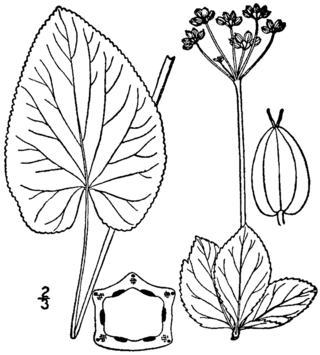Aptera Motors Corp. is an American crowd funded, pre-production startup company based in Carlsbad, California. It was originally founded in 2005 before liquidating in 2011. The company was relaunched by the original founders in 2019.
Inga aptera is a species of plant in the family Fabaceae. It is found only in Brazil.

Apteromantis aptera is a species of praying mantis endemic to the Iberian Peninsula. It was first described by José María Hugo de la Fuente Morales in 1894. It was previously considered to be endangered by the IUCN, but has been downgraded to least concern, as the populations are rising and they are spreading to new habitats in south-central Spain and southern Portugal.
Hopea aptera is a species of plant in the family Dipterocarpaceae. It is endemic to Papua New Guinea. The tree is harvested from the wild for its timber, which is widely used within the tree's native range. The plant is classified as 'Data Deficient' in the IUCN Red List of Threatened Species.

Parashorea is a genus of plant in family Dipterocarpaceae. The name Parashorea is derived from Greek and refers to the genus similarity to Shorea. It contains about 15 species distributed from South Myanmar, Thailand, Indo-China and the southernmost parts of China to Sumatra, Borneo and the Philippines.
Parashorea densiflora is a species of plant in the family Dipterocarpaceae. It is a tree endemic to Peninsular Malaysia.
Parashorea lucida is a species of plant in the family Dipterocarpaceae. The name lucida is derived from Latin and refers to the venation on the leaf. It is a tall emergent tree, up to 60 m tall, found in mixed dipterocarp forest on clay and clay soils. It is found in Sumatra and Borneo. It is threatened by habitat loss.

Parashorea macrophylla is a species of plant in the family Dipterocarpaceae. The name macrophylla is derived from Greek and refers to the species extremely large leaves. It is endemic to Borneo, being found in Brunei, Sarawak and West Kalimantan. The timber is sold under the trade name of white lauan or white seraya. It occurs in protected areas in Sarawak but elsewhere it is threatened by habitat loss.

Parashorea malaanonan is a species of plant in the family Dipterocarpaceae. it is found in the Philippines and the northeast coast of Sabah in Borneo. The name malaanonan is derived from Tagalog and is a putative vernacular name for this species. It is a large emergent tree, up to 60 m, found in mixed dipterocarp forests on deep friable clay soils. It can still be found in forest reserves in the east coast of Sabah although elsewhere it is threatened by habitat loss. The timber is a light hardwood sold under the trade name of white lauan or white seraya.
Parashorea stellata is a species of tree in the family Dipterocarpaceae. It grows naturally in Laos, Peninsular Malaysia, Myanmar, Thailand, and Vietnam. It is threatened by habitat loss.
Shorea acuminata is a species of plant in the family Dipterocarpaceae. It grows naturally in Sumatra and Peninsular Malaysia.

A solar car is a solar vehicle for use on public roads or race tracks. Solar vehicles are electric vehicles that use self-contained solar cells to provide full or partial power to the vehicle via sunlight. Solar vehicles typically contain a rechargeable battery to help regulate and store the energy from the solar cells and from regenerative braking. Some solar cars can be plugged into external power sources to supplement the power of sunlight used to charge their battery.
Parashorea tomentella is a species of plant in the family Dipterocarpaceae. It is endemic to eastern Borneo. It is a large emergent tree, up to 65 m tall, found in lowland dipterocarp forests on fertile clay soils. It is a light hardwood sold under the trade names of White Lauan or White Seraya. It is found in forest reserves on the east coast of Sabah.
Parashorea smythiesii is a species of plant in the family Dipterocarpaceae. It is endemic to Borneo. It is a large emergent tree, up to 55 m tall, found in mixed and upper dipterocarp forests on fertile clay soils. It is found in some protected areas.
Parashorea parvifolia is a species of plant in the family Dipterocarpaceae. The name parvifolia is derived from Latin and refers to species small leaves. It is endemic to Borneo. It is a large emergent tree, up to 60 m tall, found in mixed dipterocarp forests on fertile clay soils. It is present in protected areas, including Lambir Hills National Park.

Zizia aptera is a flowering plant native to North America. Its common names include meadow zizia, golden alexanders, heart leaved golden alexanders, and prairie golden alexanders.
Dodonaea aptera, commonly known as coast hop-bush, is a species of coastal shrub endemic to Western Australia.
Aptenopedes aptera, the wingless Florida grasshopper, is a species of spur-throated grasshopper in the family Acrididae. It is found in North America.
Lipaso Forest Reserve is a protected forest reserve in Telupid District of Sandakan Division, Sabah, Malaysia. It was designated as a Class 1 Protection Forest by the Sabah Forestry Department in 1984. Its area is 3,606 hectares (36.06 km2). The reserve is mountainous with some palm oil plantations and farms in the surroundings. The forest is mostly mixed dipterocarp. Threats to the reserve forests include fires and encroachment for agriculture.





